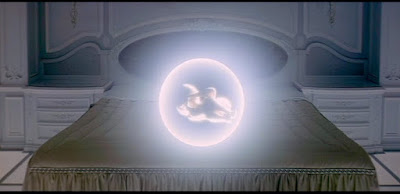



Top left: Bowman is reborn as the alien life force finishes taking over his body and mind, after he dies from his brain injury. Top right: This scene represents the same alien life force approaching Earth, where, using Bowman's physical body (which it is inhabiting), it plants the monolith we see in the Dawn of Man segment of the movie. Bowman, and the alien within him, have gone across space from Jupiter to Earth, and have gone backward in time as well, to a point in time that is several million years before the Jupiter mission takes place; how this is accomplished is explained later in the analysis. Above left and right: The famous match cut between bone and orbiting nuclear weapons satellite,[a] signifies the transition from the chronological ending of the movie back to its beginning: The Dawn of Man segment, though shown first, is, chronologically speaking, the final segment of the film. Viewed in another sense, the movie actually goes on forever, as if on an endless 'replay' loop. Thus, it is a circular narrative, as is Tarantino's Pulp Fiction, and it can also be viewed as being like a Möbius strip, similar to Lynch's Mulholland Drive. This circularity is, in part, due to the fact that when considered within the context of the order in which they are shown to the audience, all three films effectively begin and end with alchemical nigredos: At 2001's beginning, there is chaos among the ape-men upon the appearance of the monolith, and at its end, the nigredo is signified by the beginning of the elderly Bowman's physical decomposition; at the beginning of Pulp Fiction, there is chaos in Brett's apartment, and at the end, chaos in the diner being robbed; and finally, in Mulholland Drive, there is the chaos at the beginning of the film in that this is when the auto accident occurs, and at the end, when Diane Selwyn 'sees' (i.e., hallucinates) the man and woman who raised her haranguing her, and subsequently shoots herself.
a. The orbiting object is a nuclear weapons satellite: The Making of Kubrick's 2001. Ed. Jerome Agel. Signet, 1970. p. 196 and caption in photographs section.